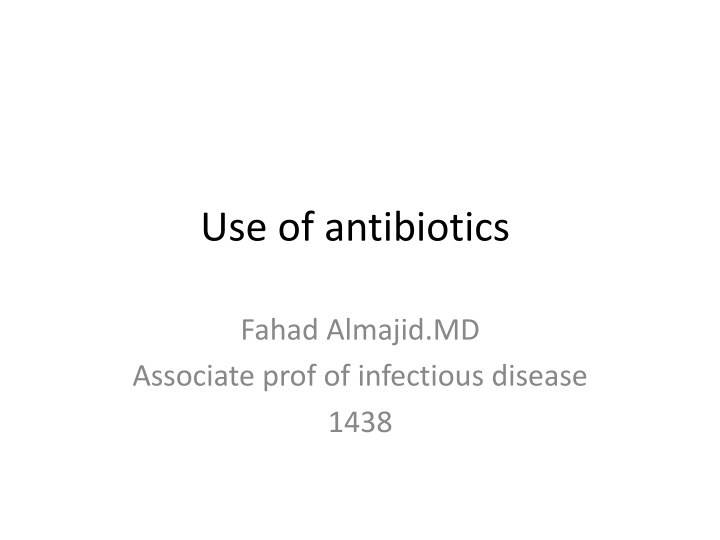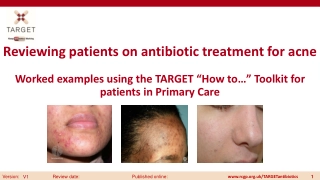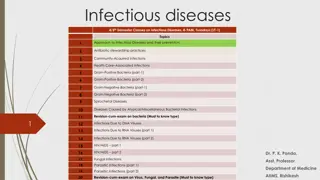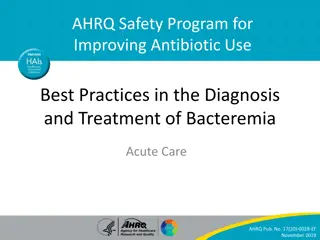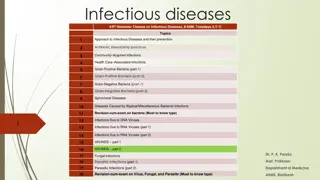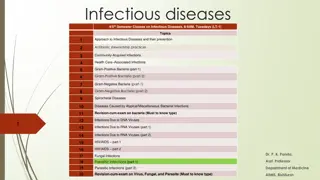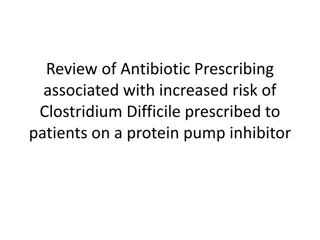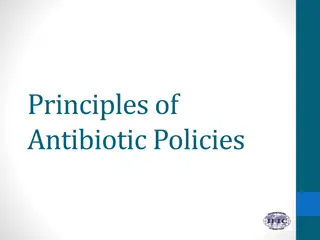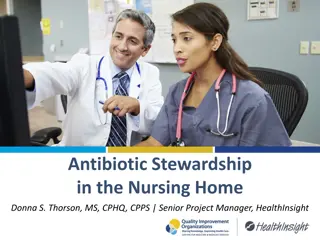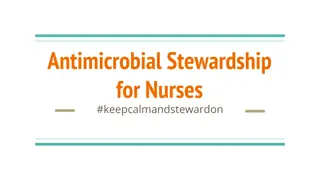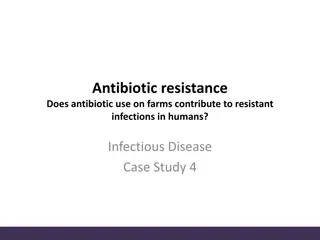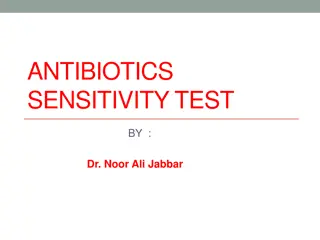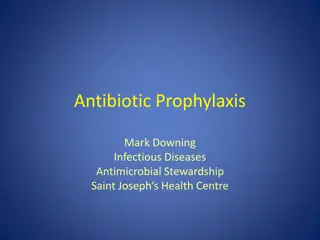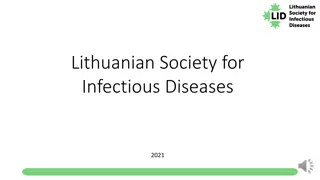Best Practices for Antibiotic Use in Infectious Diseases Management
Antibiotics play a crucial role in preventing and treating diseases, but misuse and overprescription are common issues. Dr. Fahad Almajid emphasizes the importance of accurate diagnosis, host factors consideration, and microbiology testing for effective treatment. Identifying life-threatening infections promptly, tailoring antimicrobial therapy based on clinical presentation, and detailed exposure history assessment are key strategies. The urgency of starting antibiotics varies based on the condition, while withholding antibiotics in stable circumstances can aid in pathogen identification. Choosing between empirical and definitive therapy, considering drug-resistant organisms, and narrowing antibiotic spectrum based on microbiological findings are vital steps in optimizing treatment outcomes.
Download Presentation

Please find below an Image/Link to download the presentation.
The content on the website is provided AS IS for your information and personal use only. It may not be sold, licensed, or shared on other websites without obtaining consent from the author.If you encounter any issues during the download, it is possible that the publisher has removed the file from their server.
You are allowed to download the files provided on this website for personal or commercial use, subject to the condition that they are used lawfully. All files are the property of their respective owners.
The content on the website is provided AS IS for your information and personal use only. It may not be sold, licensed, or shared on other websites without obtaining consent from the author.
E N D
Presentation Transcript
Use of antibiotics Fahad Almajid.MD Associate prof of infectious disease 1438
When antibiotics are needed to prevent or treat disease, they should always be used. But research has shown that: as much as 50% of the time, antibiotics are prescribed when they are not needed or they are misused.
Obtain accurate ID diagnosis Site Define host: Immunocompromized, DM, ELDERLY Establish microbiology DX
Serious life-threatening infection and require prolonged therapy: It is critical to isolate the organism: IE Septis arthritis meningitis
Antimicrobial therapy chosen on basis of cliniical presentation: If no response investigate to 1] determine aetiology 2] exclude non-infectuoous
Detailed exposure history: Example: Patient with non resloving pneumiina: Further history revealed Travel to : southwestern US: DX: Cocdiodomycosis.
Time of start antibiotics: HOW MUCH URGENT? SEPTIC SHOCK FEBRILE NEUTROPENIA Bacterial meningitis Immediate.
Stable clinical circustances: Antimicrobial deliberately withheld: To collect appropriate specemin. Example : SBE Vertbral osteomylitis / discitis. Quich start: suppress growth..miss pathogens.
Empric vs definite Broad spectrum and combination: Example Meningitis Catheter related bacteremia VAP HCAUTI.. CONSIDER DRUG RESISTANT ORGANISMS.
Microbiology identified Narrow the antibiotics spectrum 1] cost 2] toxxicity 3] prevent emergence of resistance
Interpretation of Antimicrobial Susceptibility Testing Results measures the ability of a specific organism to grow in the presence of a particular drug in vitro Data are reported in the form of minimum inhibitory concentration (MIC), MIC: is the lowest concentration of an antibiotic that inhibits visible growth of a organism: Sensitive, resistant, intermediate
Bactericidal vs Bacteriostatic Therapy Bactericidal drugs, which cause death and disruption of the bacterial cell, include drugs that primarily act on the: cell wall (eg, b-lactams), cell membrane (eg, daptomycin), or bacterial DNA (eg, fluoroquinolones)
Bacteriostatic agents inhibit bacterial replication without killing the organism.: sulfonamides, tetracyclines, and macrolides, act by inhibiting protein synthesis. The distinction is not absolute
Use of Antimicrobial Combinations Agents Exhibit Synergistic Activity Against a Microorganism: The combined effect of the agents is greater than the sum of their independent activities when measured separately. b-lactams and aminoglycosides exhibits synergistic activity against Enterococcus endocarditis.
synergistic combinations can also be used to shorten the course of antimicrobial therapy : Endocarditis due to viridans group streptococci, a combination of penicillin or ceftriaxone with gentamicin for 2 weeks can be as effective as penicillin or ceftriaxone alone for 4 weeks).
Host Factors to Be Considered in Selection of Antimicrobial Agents One size fits all Renal and Hepatic Function: primary organs responsible for elimination of drugs from the body .. dose reduction to prevent accumulation and toxicity Pregnancy and Lactation. Penicillins, cephalosporins, and macrolides : considered safe
sulfonamides and nitrofurantoin, which were not previously considered harmful in early pregnancy, were found to be associated with several birth defects.
History of Allergy or Intolerance Oral vs Intravenous Therapy: well-absorbed oral antimicrobial agents (eg, treatment of pyelonephritis and community- acquired pneumonia with oral fluoroquinolones. Patients initially treated with parenteral therapy can be safely switched to oral antibiotics when they become clinically stable
bioavailability antibiotics with excellent bioavailability are : Fluoroquinolones, Linezolid, Trimethoprim-sulfamethoxazole, Metronidazole. BUT NOT FOR : Meningitis Infective endocarditis.
Efficacy at the Site of Infection The efficacy of antimicrobial: 1] in vitro antimicrobial activity 2] achieving adequate serum levels, Agents depends on their capacity to achieve a concentration equal to or greater than the MIC at the site of infection: Ocular fluid, CSF, abscess cavity, prostate, and bone: Antimicrobial concentration sare often much lower than serum levels.
A) Cephalosporin : first & second- generations b) Macrolides: Do not cross the blood-brain barrier Are not recommended for CNS infection. Fluoroquinolones achieve high concentrations in the prostate: Are preferred oral agents for the treatment of prostatitis
Daptomycin, an excellent bactericidal agent against gram-positive bacteria .BUT is not useful for treatment of pneumonia because it is inactivated by lung surfactant.
Aminoglycosides are less active in abscesses: the low-oxygen low-pH Drainage of abscesses to enhance antimicrobial efficacy is recommended.
Moxifloxacin does not achieve significant urinary concentrations, because of its low renal excretion Not suitable for treatment of UTIs. in conrast: Levofloxacin and ciprofloxacin are excellent choices for UTIs
Duration of Antimicrobial therapy In many such infections, treatment duration has to be carefully individualized on the basis of clinical and radiologic response: 4-6 weeks for: Endocarditis, osteomyelitis, and intra- abdominal abscesses, weeks to months for : invasive fungal infections.
Assessment of Response to Treatment clinical and microbiological parameters Clinical parameters : symptoms and signs : A) A decrease in fever, tachycardia, or confusion. B) laboratory values (eg, decreasing leukocyte count), and C) Radiologic findings (eg, decrease in the size of an abscess) LAG behind
Assessment of Response to Treatment Radiographic follow-up of patients with community-acquired pneumonia, 1) clinical cure was observed in 93% of patients after 10 days of follow-up, whereas , 2) Radiographic resolution was noted in only 31% of patients.
Assessment of Response to Treatment microbiological parameters Clearance of the bloodstream . Persistent bacteremia can often be the only clue to the presence of: 1) An inadequately treated source 2) The existence or development of endovascular infection : such as : Endocarditis or an intravascular device infection 3) Emergence of antimicrobial resistance
Adverse Effects Allergic or hypersensitivity reactions can be either : 1) Immediate (IgE-mediated) or 2) Delayed and usually manifest as a rash: anaphylaxis is the most severe manifestation of IgE-mediated allergy.
Self-report: Of antibiotic allergies can be quite unreliable 10% to 20% of patients reporting a history of penicillin allergy were truly allergic when assessed by skin testing.
Nonallergic drug toxicity is usually, but not always, associated with higher doses and/or prolonged use. a) Nephrotoxicity with aminoglycosides, b) Neurotoxicity with penicillins. c)Peripheral neuropathy with prolonged use of metronidazole
Drug interaction Many antimicrobial agents interact with other drugs to increase or decrease their serum levels: antimicrobial agents that are metabolized by and/or affect the cytochrome P450 enzyme System: Rifampin is a powerful inducer Macrolides and azole antifungal agents are inhibitors
Antimicrobial Therapy for Foreign BodyAssociated Infections Prosthetic implants and devices: A) temporary :urinary catheter, central venous catheter) B) permanent : prosthetic joint, artificial heart valve.. The formation of biofilms: community of bacterial cells enclosed in a self- produced polymeric matrix.
Biofilms: Bacteria growing in biofilms have been shown to be relatively protected from the effects of antimicrobial therapy. prolonged antibiotic treatment for these infections can be : A) ineffective, B) adverse effects, C) emergence of resistant strains of organisms.
Difficulty of eradicating infections with antimicrobial therapy alone: Certain agents : rifampin fluoroquinolones have better activity against staphylococci in biofilms BUT Removal of the implant is often necessary for cure.
Use of Antimicrobial Agents as Prophylactic or Suppressive Therapy Presurgical Antimicrobial Prophylaxis to reduce the incidence of postoperative surgical site infections. Patients undergoing : 1) Procedures associated with high infection rates. 2) Implantation of Prosthetic material, and those in which the consequences of infection are serious.
Use of Antimicrobial Agents as Prophylactic or Suppressive Therapy A single dose of a cephalosporin (such as cefazolin) administered: targets the most likely organisms : skin flora a] within 1 hour before the initial incision is appropriate for most surgical procedures. b] Duration should not exceed 24.
Use of Antimicrobial Agents as Prophylactic or Suppressive Therapy Antimicrobial Prophylaxis in Immunocompromised Patients.. HIV patient with low CD4 (less than 200) is at high risk for Pneumocystis pneumonia: Trimethoprim-sulfamethoxazole 1 DS tab Daily will prevent the infection.
Antimicrobial Prophylaxis to Prevent Transmission of Communicable Pathogens to Susceptible Contacts. Ciprofloxacin can be given to close contacts of a patient with meningitis caused by N meningitidis.
JUDICIOUS USE OF ANTIMICROBIAL AGENTS Antimicrobial Stewardship: Optimizing antimicrobial : Selection, dosing, route, and duration of therapy to maximize clinical cure or prevention of infection while.. limiting the unintended consequences, such as: A] The emergence of resistance. B] Adverse drug events, C] cost
Preventing Emergence of Antibiotic Resistance the single most important cause of the emergence of drug resistance: The widespread and often inappropriate use of antimicrobial agent. VERY COMMON PRACTIC: Antibiotics for viral URTI.???? WHAT TO DO ? Avoid antibiotic use for viral, upper respiratory tract infections; Use narrow-spectrum antibiotics when possible.
Common Misuses of Antibiotics 1) Prolonged Empiric Antimicrobial Treatment Without Clear Evidence of Infection: EXAMPLE: 1] adult onset Still disease 2] the fever associated with pulmonary embolism; 3] lymphoma
Common Misuses of Antibiotics CASE: 35 years old women presented with : Fever, sinusitis and cavitary lesions in te lungs: Q: will you start antibiotics or not : NO DX: Wegener granulomatosis
Common Misuses of Antibiotics 2) Treatment of a Positive Clinical Culture in the Absence of Disease. Colonization with potentially pathogenic organisms without manifestation of disease: A) The urinary tract in the presence of an indwelling urinary catheter. b) Endotracheal tubes in mechanically ventilated patients. C) chronic wounds.
Common Misuses of Antibiotics Appropriate management in these situations: Is to : obtain cultures from these sites only when indicated Avoid treatment of a positive culture result when symptoms and signs of active infection are absent (eg, asymptomatic bacteriuria).
Common Misuses of Antibiotics 3) Failure to Narrow Antimicrobial Therapy When a Causative Organism Is Identified Once culture and susceptibility data are available, an antibiotic with the narrowest possible spectrum should be selected for continuation .but..this does not occur if the patient has improved while receiving empiric therapy.
Common Misuses of Antibiotics 4) Prolonged Prophylactic Therapy. , the common practice of prolonging antimicrobial therapy until the removal of surgical drains is not evidence based. What is the sequale ? Simply sets the stage for the emergence of antimicrobial resistance.
Common Misuses of Antibiotics Excessive Use of Certain Antimicrobial Agents. A) he increased use of fluoroquinolones resulted in fluoroquinoloneresistant strain of C difficile. B) increase in levofloxacin use as initial therapy for UTI . led to a rapid increase in fluoroquinolone resistance among outpatient urinary E coli isolates .
avoid the excessive prescribing of a single class of antibiotic
Appropriate use of antimicrobial agents 1) obtaining an accurate diagnosis. 2) determining the need for and timing of antimicrobial therapy. 3) understanding how dosing affects the antimicrobial activities of different agents. 4) tailoring treatment to host characteristics, using the narrowest spectrum and shortest duration of therapy.
